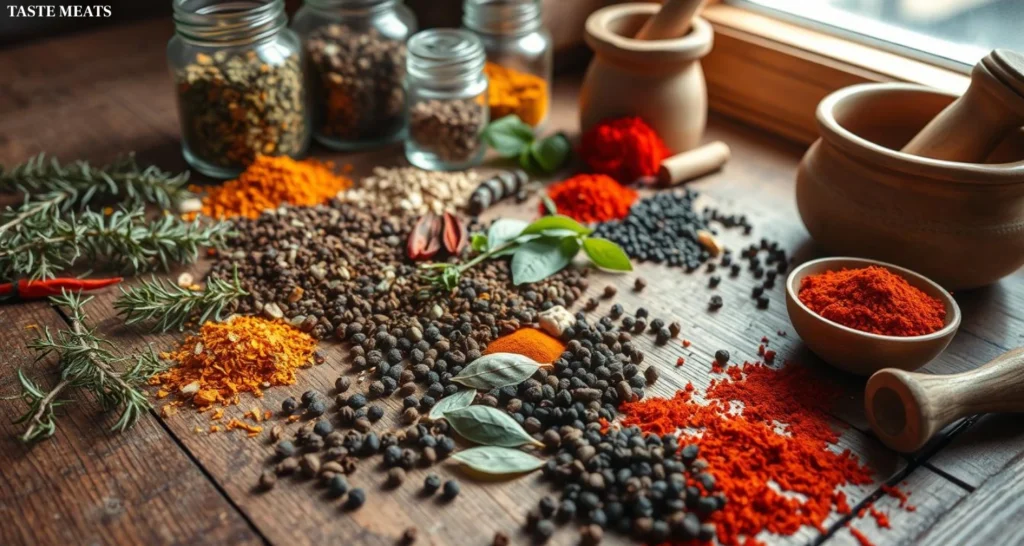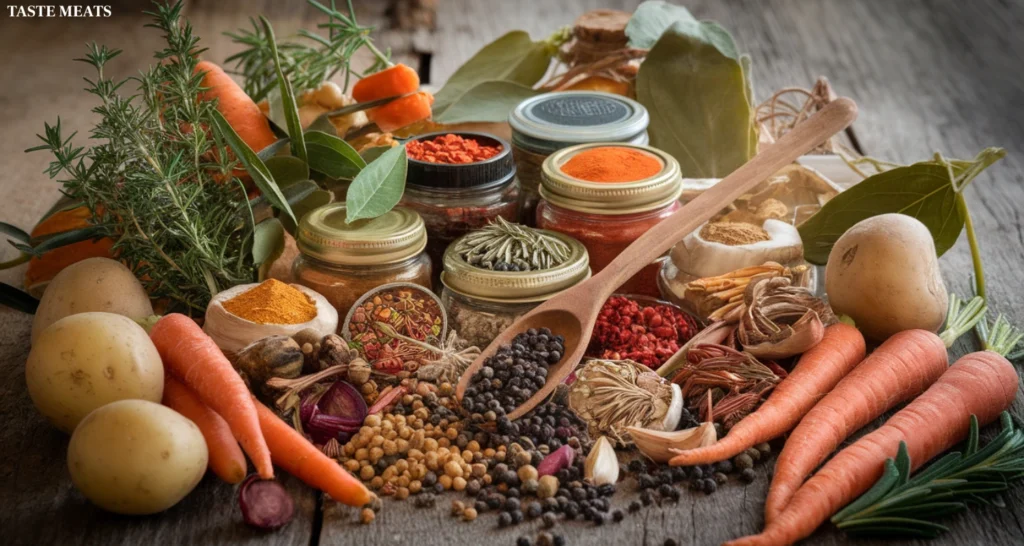When the weather gets cooler and the days get shorter, nothing beats the smell of a beef stew cooking. The secret to a great stew isn’t just the meat. It’s the right mix of seasonings that makes it truly special. Today, I’m excited to share a homemade beef stew seasoning recipe to improve your stew.
Table of Contents
Understanding the Importance of Quality Stew Seasoning
Creating a delicious beef stew starts with the right seasoning. Store-bought packets might be easy, but they lack the deep flavours your stew needs. They often have too much sodium and may include unhealthy additives, affecting your dish’s taste and health.
Why Store-Bought Seasonings Fall Short
Looking at the nutrition facts shows why store-bought seasonings aren’t the best. For example, McCormick’s Beef Stew Seasoning Mix has 240mg of sodium per serving. Penzeys Spices and The Spice Hunter have 190 and 270 mg, respectively. But the homemade seasoning blend in this article lets you control the salt, making your stew healthier and tastier.
Benefits of Homemade Seasoning Blends
Making your stew seasoning allows you to tailor the flavours to your taste. Mixing fresh, quality spices and herbs creates a rich, aromatic base. This boosts the natural flavours of beef and vegetables, making your stew more delicious. It also lets you meet dietary needs like low-sodium or gluten-free.
Creating your stew seasoning is a kitchen game-changer. You can take your beef stew to new flavour heights with full control over the ingredients. This leaves store-bought packets far behind.

Essential Ingredients for Beef Stew Seasoning
Creating the perfect beef stew starts with the right spices and herbs. The base spices include flour, onion powder, black pepper, and paprika. Also key are celery seed, dried basil, dried parsley, salt, dried oregano, and dried rosemary. Together, they make a savoury seasoning that brings out the best in the beef and vegetables.
Base Spices and Their Roles
- Flour: Helps to thicken the stew and create a velvety texture.
- Onion powder: Provides a sweet, aromatic base note.
- Black pepper: Adds a warm, peppery kick.
- Paprika: Contributes a subtle smoky, earthy flavour.
- Celery seed: Lends a subtle herbaceous note and complexity.
- Dried basil and parsley: Contribute fresh, herbal undertones.
- Salt: Enhances and balances the overall flavour profile.
- Dried oregano and rosemary: Offer depth and robust, woodsy notes.
Optional Flavor Enhancers
Consider adding garlic powder, smoked paprika, or white pepper for even more flavour. These optional ingredients add complexity and let you tailor the seasoning to your liking.
Remember, the secret to great beef stew seasoning is finding the right balance. Experiment with different spice ratios to create a blend that makes your stew unforgettable.

The Role of Herbs in Stew Seasonings
Herbs are key to making a great beef stew. They add depth and a unique flavour that complements the beef. Herbs like rosemary and thyme make your stew taste better.
Some top herbs for beef stew include:
- Basil: It adds a sweet flavour with hints of liquorice and mint.
- Parsley: It brings a fresh taste that makes the dish pop.
- Oregano: It gives a warm, peppery flavour perfect with beef.
- Rosemary: It offers a strong, pine-like taste that matches the beef’s heartiness.
- Thyme: It adds a subtle earthy and minty flavour that combines everything.
It is a good idea to use both dried and fresh herbs in your stew. Dried herbs are great for seasoning blends because they last longer, while fresh herbs add a lively taste and can be used in larger amounts.

Whether dried or fresh, herbs bring a flavour to your stew that spices can’t match. Try different herb mixes to find the best one for your stew.
Creating the Perfect Spice Balance
Making a balanced beef stew seasoning is key to a delicious dish. Start with basic spices and adjust to taste for a perfect beef stew seasoning recipe. This way, you get a balanced seasoning blend that’s just right for you.
Measuring and Mixing Techniques
Accurate measurements are crucial for great results. Use spoons to get the right amount of each spice. Mix well to spread the flavours evenly. This avoids one spice dominating, blending all flavours.
Adjusting Flavors to Taste
The initial beef stew seasoning recipe is a good start, but feel free to tweak it. If the cayenne is too hot, cut it back. Want more pepper? Add some. Finding the right mix of savoury, sweet, and spicy is all about balance. Keep adjusting until it’s just right for your stew.
Homemade seasoning blends let you customize to your liking. With a few tweaks, your beef stew seasoning recipe can take your stew to new flavour heights.
How to Store Your Homemade Beef Stew Seasoning
It’s important to keep your homemade beef stew seasoning fresh and flavorful so you can enjoy its rich taste repeatedly. Follow these easy steps to keep your seasoning blend tasty for up to 6 months.
- Put the seasoning in an airtight container or jar. You can use a resealable plastic bag, a glass spice jar, or a Mason jar with a tight lid.
- Place the container in a cool, dry spot away from sunlight. Your pantry or a kitchen cabinet is perfect.
- Write down the date you made the seasoning and include the ingredients on the container. This helps you remember when it was made.
- If you want to store it longer, put it in the fridge or freezer. This can make it last up to 6 months.
- Before using it, shake or stir the container well. This mixes the spices and checks if it smells fresh.
You can enjoy your homemade beef stew seasoning for months following these tips. Proper storage of homemade seasoning is key. It helps keep the seasoning’s shelf life good and makes your stew recipes always great.
The Secret to Rich and Flavorful Beef Stew
Creating a flavorful beef stew is all about seasoning. It’s about when and how you add spices and herbs. With a few simple steps, you can make an unforgettable stew.
Timing of Seasoning Application
Start by seasoning the beef cubes before browning them. This lets the spices soak into the meat, and the Maillard reaction during searing makes the flavours even better.
Layering Flavors During Cooking
- Brown the meat in batches for a rich base. Use wine, beer, or broth to get those tasty browned bits.
- Add onions, carrots, and celery at the start. They give the stew a classic taste.
- Put in more seasonings at different times. This way, the flavours blend perfectly.
- Finish with fresh herbs just before serving. They add a fresh touch to the stew.
Mastering seasoning timing and layering makes your beef stew truly special. It becomes a rich and satisfying dish.
Best Cuts of Beef for Seasoned Stew
Choosing the right meat is key for a delicious beef stew. Instead of “stew meat,” go for well-marbled beef chuck. It’s tender and full of flavour. Chuck roast is great because it has fat that makes the meat tender when cooked long.
Make sure to cut the beef into 1.5-inch cubes before stewing. This size cooks evenly. You can also try brisket or short ribs for a different taste. Cuts with more fat are better because they stay moist and taste richer.
Quality ingredients make a great beef stew. Your stew will be amazing if you pick the best cuts and prepare them right.
Alternative Uses for Beef Stew Seasoning
Versatile Applications Beyond Stew
The beef stew seasoning you’ve made is great for more than just stew. Use it to make your dishes more flavorful. It’s perfect for adding depth to many recipes.
Try it as a dry rub for steaks or roasts. It adds a delicious taste. Sprinkle it on roasted veggies like potatoes and carrots for extra flavour. Mix it into ground beef for tasty burgers or meatloaf.
This seasoning isn’t just for beef. It’s also good in soups, gravies, and sauces. Add it to chilli or braising liquid for a flavour boost. Mix it with butter for a compound butter to spread on bread or grilled meats.

